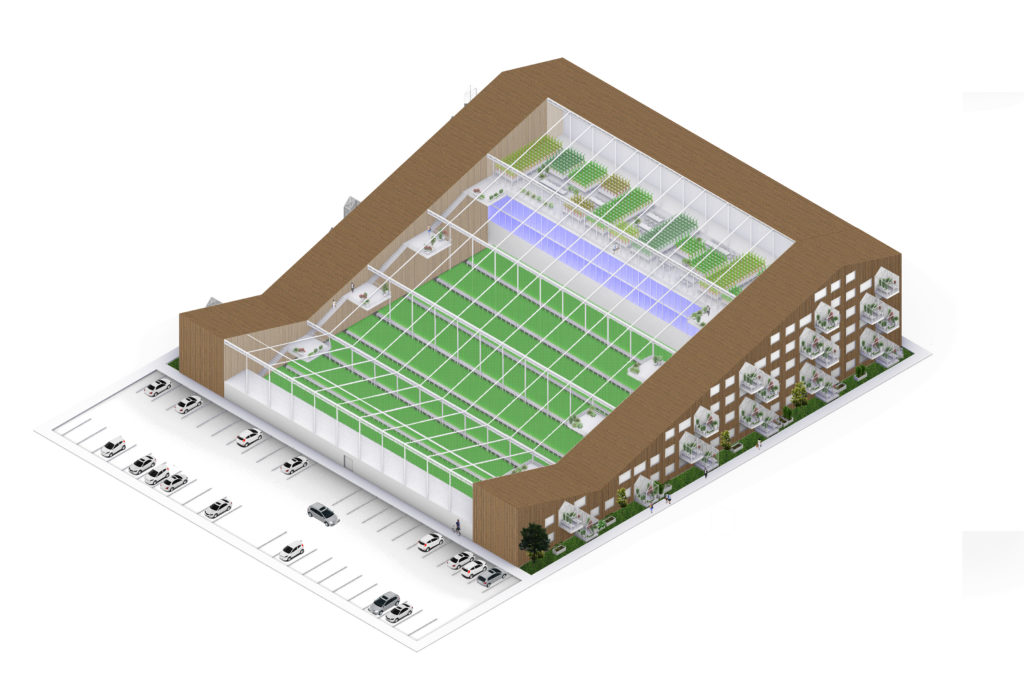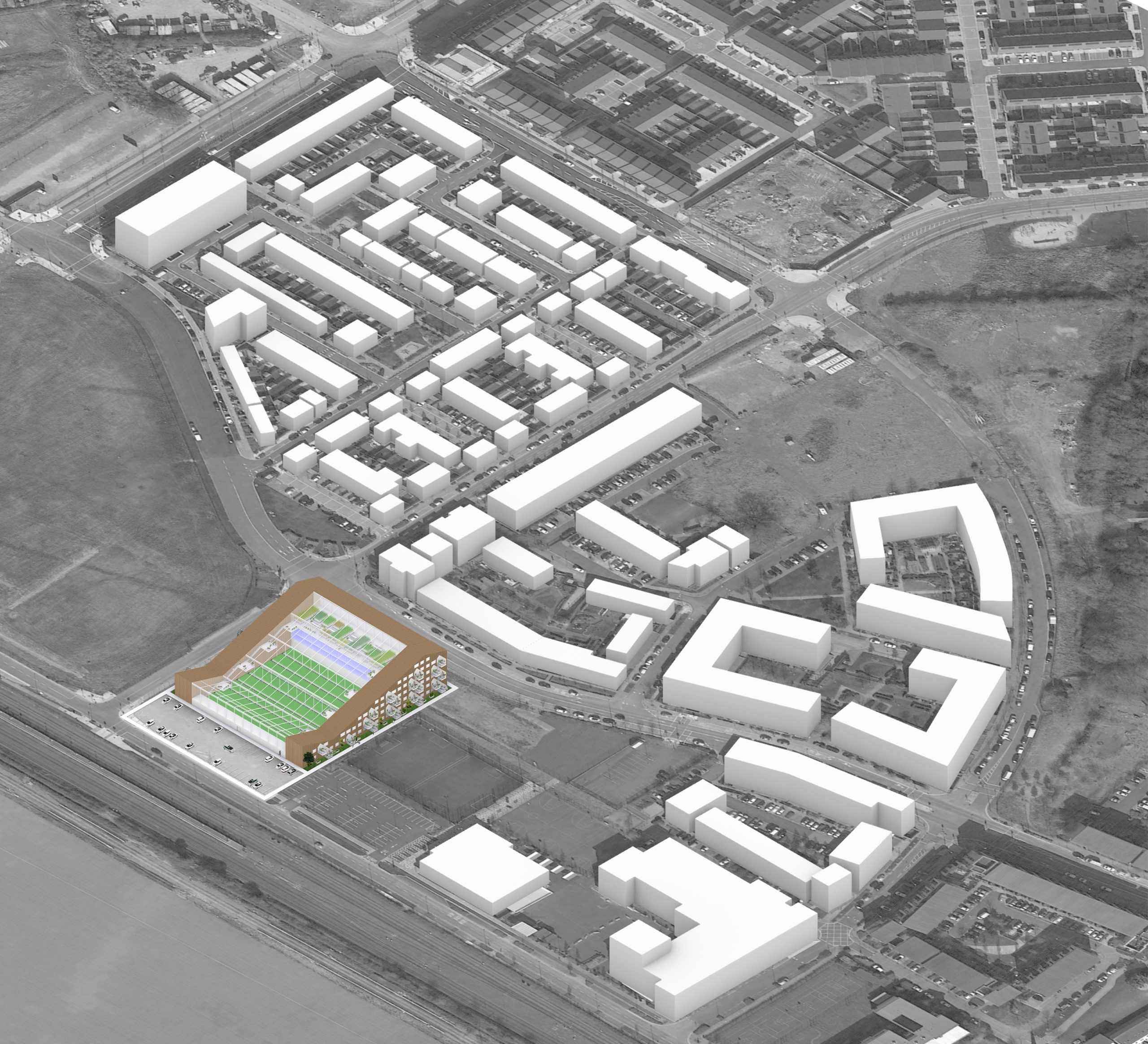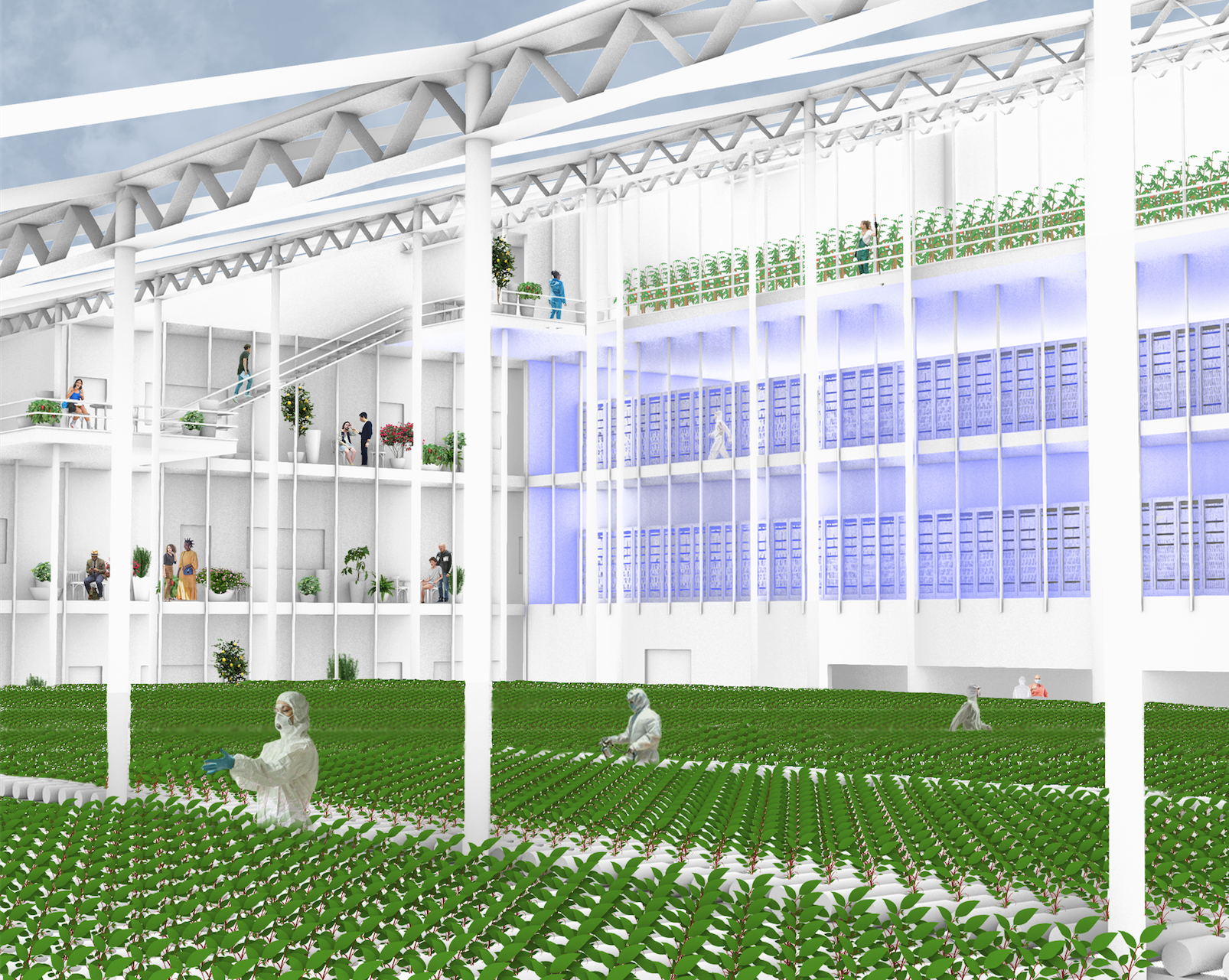
Clare Lyster CLUAA, Farm Life (Figure 4)
Clare Lyster CLUAA, Charles Lafon CLUAA, Mary Harty Assistant Professor UCD School of Agriculture, Dr. Fiona Mc Dermott CONNECT, Trinity College Dublin
For our third ‘Call to Action!’, drawn from submissions to the Housing Unlocked Open Call, we present Clare Lyster, Charles Lafon, Mary Harty and Fiona Mc Dermott’s proposal to establish productive synergies between farming infrastructure, data storage centres and housing. Enjoy!

Farm Life highlights the possibility to unlock housing through synergies with other industrial and metabolic flows in the built environment. It is a domestic prototype that integrates housing, data storage and greenhouse farming in an exurban location outside Dublin. A strip of housing surrounds a commercial greenhouse, and both are heated courtesy of the exhaust energy from an adjacent data storage facility (a data farm), or a facility on site. 60 units ranging from 1 bedroom to 3-bedroom duplexes are provided with shared and individual interior and exterior gardens. Vertical farming can also be accommodated. The test bed site is at Adamstown, but the project can be located at other sites along the M50 adjacent large data facilities for Google, Microsoft and Amazon. (Figure 1: right)

Industrial Symbiosis
“Industrial symbiosis” is the utilization of waste from one industry as a resource for another. In the case of this project, heat energy from the numerous data storage facilities on the periphery of the city is transferred to hot water and used as a resource for home heating and commercial food production at the site of the proposed project. District heating is not a new concept, but that Ireland could capitalize on its excess of data centers for energy is an emerging idea that could impact how housing is designed and where it is in the greater Dublin area. Alternatively, if a site adjacent a data center is not viable, the project can accommodate micro-data storage on site at a scale sufficient to sustain itself acting as a model for distributed data storage in contrast to the mega hyperscale facilities that currently exist. (Figure 2, left)

Farming as Community Agent
The commercial greenhouse and vertical farm provide local vegetables and micro-greens for residents and the adjacent community. Agriculture is also conceived as a social catalyst. A range of interior, and exterior private gardens provide numerous opportunities to grow food and other plant life individually or collectively. Access corridors to the units are conceived as “garden alleys” while landings perform as shared meeting and gardening spots. The main central commercial garden is managed by a third party (as is the data storage), but residents can contribute to maintenance, planting and harvesting regimes. Senior residents with green fingers find a venue for their know-how while children play and learn the importance of local food sources and a healthy diet. Lastly, automated equipment (robots and seeders) emphasizes the entanglement of technological systems in new modes of intensive food production. In the end, and like other famous agricultural plans from Le Corbusier’s, Ferme Radieuse (1930s) to Andrea Branzi’s, Argonica (1995), agriculture is presented less as a measure for resiliency and, or self-sufficiency and more as a conceptual model for new territorial collectives. (Figure 3, right).

Site Revitalization
Farm Life is more than a housing project built around industrial relationships. It is also a cultural icon in the neighborhood. For too long housing estates on the periphery of the city are bereft of cultural and community amenities. Farm Life acts as a landmark in the area. Pink LED grow lights glow at dusk and are visible from the M50, while food production provides a dramatic sensory and visual atmosphere. Residents are proud to proclaim, “I live there”—The Hanging Gardens of Adamstown.
In summary, the combination of data, farming and housing provides a more holistic approach to residential development by leveraging the metabolic flows of the contemporary city as a catalyst to reshape the countryside and to offer sustainable and artful relationships between digital infrastructure, land, urban life, and domesticity moving forward. In this way, the project advocates for the integration of systems as a model for future development to help build linkages between us and the social, technical and capitalist assemblages that organize contemporary lifestyle. Furthermore, the project ignores the dualism between nature and technology, a tenet of the modern city, by using the bits, bytes and energy flows of digital communication to grow lunch. Data infrastructure and bodily functions are one.
Team
CLUAA | Clare Lyster
CLUAA | Charles Lafon
Mary Harty, Assistant Professor, UCD School of Agriculture
Dr. Fiona Mc Dermott, CONNECT, Trinity College Dublin
Captions:
Figure 1 (GIF): Farm Life. Potential site locations, Dublin. CLUAA, August 2022
Figure 2: Farm Life. Site axonometric. CLUAA, August 2022
Figure 3: Farm Life. Interior View. CLUAA, August 2022.
Figure 4: Farm Life. Isometric View. CLUAA, August 2022.
![Re-watch the ‘Timeless Challenge : Talking Housing [Histories, Futures and Now]’ lecture series](https://housingunlocked.ie/wp-content/uploads/2024/01/Dr-Daithi-Downey-Chair-Talking-Housing-Histories.png)
Dr Dáithí Downey chairs the 'Talking Housing Histories' session in the Housing Unlocked Living Room space.
IAF, Contributors
Read Now

Photo: Business to Arts Awards 2023 winners of Best Creativity in the Community, supported by Irish Life. Photo by Conor McCabe.
Read Now